
Fig.1
Jan Siberechts
Landscape with Rainbow, Henley-on-Thames c.1690
T00899
Tate
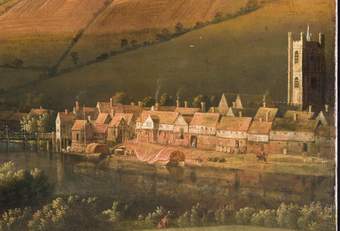
Fig.2
Detail of Landscape with Rainbow, Henley-on-Thames c.1690, showing the church and the town at the right edge
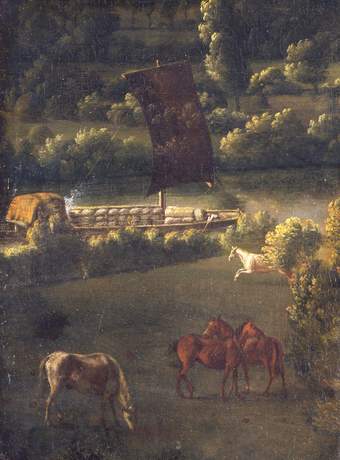
Fig.3
Detail of the landscape of Landscape with Rainbow, Henley-on-Thames c.1690, showing a barge and animals
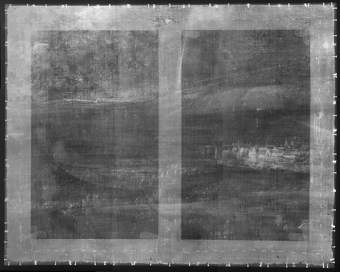
Fig.4
X-radiograph of Landscape with Rainbow, Henley-on-Thames c.1690
This painting is in oil paint on canvas measuring 819 x 1029 mm (figs.1–3). The single piece of plain woven, linen canvas has cusping on the right edge (fig.4).1 The cusping would cast doubt on any suggestion that the composition has been trimmed significantly at this edge, even though the position of the church tower so close to that edge seems unusual. None of the tacking edges is present. The glue-paste lining and adjustable wooden stretcher probably date from the first half of the twentieth century.
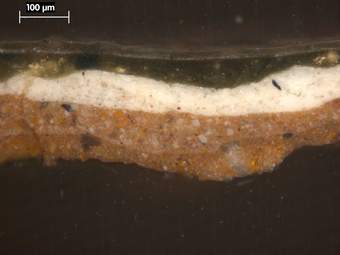
Fig.5
Cross-section through foliage and sky at the left edge, 259 mm from the top corner. Photographed at x200 magnification. From the bottom of the sample upwards: two coats of tan coloured ground; thin, sketchy underpaint of sky containing glassy particles in an opaque white matrix with fine black, red and yellow particles; pale blue sky paint; green paint of foliage; varnish layers
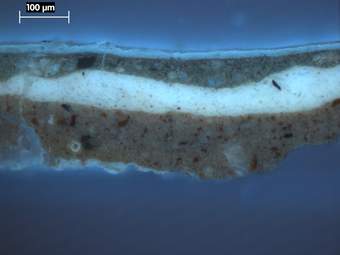
Fig.6
The same cross-section as in fig. 5, photographed at x200 magnification in ultraviolet light
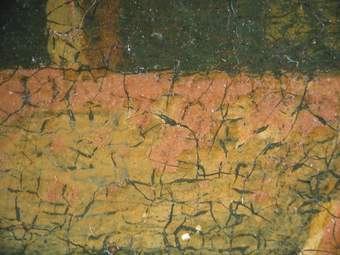
Fig.7
Detail at x10 magnification of drying cracks in a roof
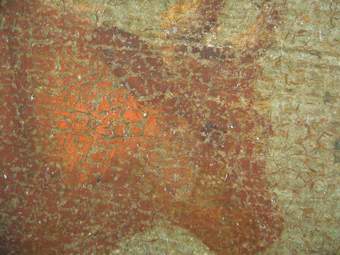
Fig.8
Detail at x8 magnification of the head of a cow, showing shrinkage cracks
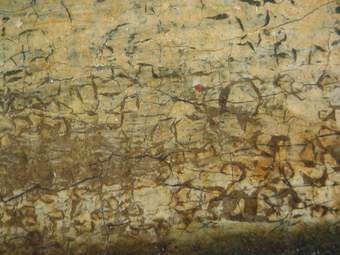
Fig.9
Detail at x10 magnification of shrinkage cracks in the base of the church tower
The thick ground is opaque tan colour; it is composed of two coats of tan coloured paint, containing chalk, lead white, sienna and other earth pigments, smalt, bone black and possibly some red lake (figs.5–6).2 It was applied smoothly, although it is now imprinted with the canvas weave as a result of lining. There is a dense network of age cracks all over the painting.
No underdrawing is evident with infrared or microscopical examination. There appears to be opaque, light coloured underpainting beneath areas of the left-hand sky and beneath the distant hills and trees. Other areas that need high reflectance, such as the rainbows, were also underpainted in opaque light-coloured paint. An area of opaque, bright mustard paint beneath the strip of bright meadow between the foreground cows and the river on the right side apparently serves the same function.
The landscape and sky were painted in before the buildings, animals and rainbows, all of which sit on top of solid well-bound paint. As a result, all these elements have developed small-scale networks of drying cracks, which somewhat reduce the effect of solidity (figs.4, 7–9). Some areas of the composition, notably the double rainbow and the sail of the barge on the left, have been retouched by later hands to compensate for the loss of tone and continuity. The dark grey sky is heavily overpainted to compensate for old overcleaning.
The colours are opaque and there is no discernible glazing. Pigment mixtures are as follows: the grey sky at the left is composed of lead white, smalt, black, Cologne earth, vermilion, red lead, yellow ochre and yellow lake; the blue sky is lead white with smalt, chalk and a trace of earth colour; greens are based mainly on verdigris, smalt and green earth, mixed with lead white, lead-tin yellow, earth colours, vermilion and occasionally yellow lake.
March 2020
